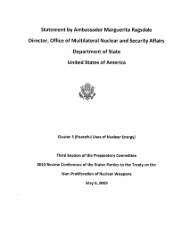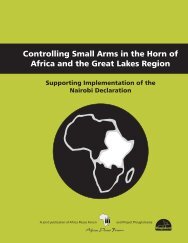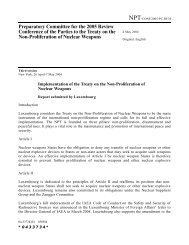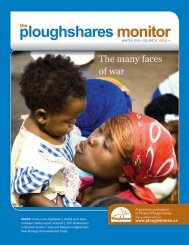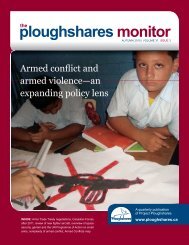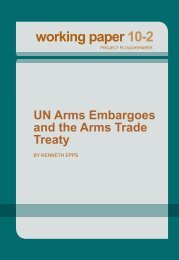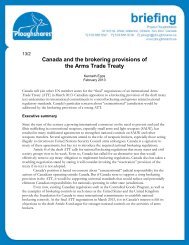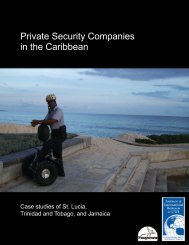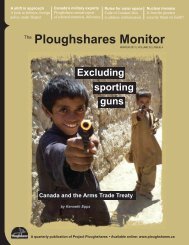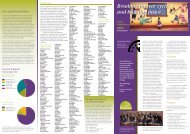Addressing Armed Violence in East Africa.pdf - Project Ploughshares
Addressing Armed Violence in East Africa.pdf - Project Ploughshares
Addressing Armed Violence in East Africa.pdf - Project Ploughshares
You also want an ePaper? Increase the reach of your titles
YUMPU automatically turns print PDFs into web optimized ePapers that Google loves.
<strong>Address<strong>in</strong>g</strong> <strong>Armed</strong> <strong>Violence</strong> <strong>in</strong> <strong>East</strong> <strong>Africa</strong>2. Research MethodologyThe impact of the peacebuild<strong>in</strong>g projects cannot be understoodwithout some explanation of the context <strong>in</strong> which the violenceis tak<strong>in</strong>g place. No attempt is made <strong>in</strong> this report, however, toprovide a comprehensive description of the history or currentdynamics of the violent conflicts <strong>in</strong> which these communitiesare engulfed or the type, number and economics of theweapons used. The complexities and nuances of the armedconflicts of the region require more extensive research andanalysis than was available to this study; researchers spent onlyone week <strong>in</strong> each country.In consultation with WV field-level colleagues, the researchteam chose a three-year timeframe for pos<strong>in</strong>g questions aboutwhether the violence was <strong>in</strong>creas<strong>in</strong>g or decreas<strong>in</strong>g. This periodcould have been longer or shorter, but it was fixed for questions<strong>in</strong> all three countries to assist <strong>in</strong> compar<strong>in</strong>g the content ofanswers.The <strong>in</strong>terview and focus group responses are the primarysource used to summarise and synthesise a description of thecontext for violence and the <strong>in</strong>struments of violence used. Anumber of secondary resources are also referenced.Figure 2.2 categorises the people <strong>in</strong>terviewed accord<strong>in</strong>g to age,gender and country.Figure 2.2: Summary of field research participantsCountryMaleadultsMaleyouthFemaleadultsFemaleyouthKenya 37 29 11Uganda 44 17 35 15Sudan 23 32 38 3Total 104 49 102 29In consultation with WV staff <strong>in</strong> <strong>East</strong> <strong>Africa</strong>, the researchersagreed that youth participants should be 18 years and older,and that all research participants, youth or adult, should befamiliar with or collaborat<strong>in</strong>g directly <strong>in</strong> WV programs. Byvisit<strong>in</strong>g communities likely to express different po<strong>in</strong>ts of view– for example, Pokot, Turkana and Marakwet communities<strong>in</strong> Kenya – researchers hoped to achieve a reasonable range ofperspectives. WV field staff selected people to participate <strong>in</strong>the research, us<strong>in</strong>g a comb<strong>in</strong>ation of convenience and snowballsampl<strong>in</strong>g techniques. Categories of people <strong>in</strong>terviewed<strong>in</strong>cluded WV staff <strong>in</strong> the host countries, local governmentofficials, security sector officials (police and military),traditional community leaders/chiefs/elders, staff of local or<strong>in</strong>ternational NGOs, religious leaders, and youth and adultsfrom the communities. In communities affected by cattlerustl<strong>in</strong>g, the last group <strong>in</strong>cluded some <strong>in</strong>dividuals identified as“warriors” or “raiders”.Data was collected by teams compris<strong>in</strong>g WV staff membersfrom the host country (staff work<strong>in</strong>g directly at the projectlevel and/or staff from the national WV headquarters), localtranslators (where necessary), and a WV Canada or <strong>Project</strong><strong>Ploughshares</strong> staff person. All notes taken from focus group,<strong>in</strong>formant and other <strong>in</strong>terviews were compiled and analysedby <strong>Project</strong> <strong>Ploughshares</strong>. The OECD-DAC armed violence lens(AVL) was used to structure the sections on each <strong>in</strong>dividualcountry and the research f<strong>in</strong>d<strong>in</strong>gs are organised accord<strong>in</strong>g tothe four AVL categories.Due to the sensitive nature of the subject matter and theongo<strong>in</strong>g violence <strong>in</strong> the communities visited, participantswere <strong>in</strong>formed that they would not be identified <strong>in</strong> the report,and that their names would rema<strong>in</strong> confidential. They were<strong>in</strong>formed about the purpose of the research, its potentialbenefits and what will be done with the results. They were alsoassured that they were free not to participate, and to decl<strong>in</strong>eto answer any question. Efforts were made to hold <strong>in</strong>terviewsand focus groups <strong>in</strong> safe places where participants could feelcomfortable to speak openly. Attention was also paid to genderrelatedsensitivities <strong>in</strong> the subject matter by, for example,hold<strong>in</strong>g several “women only” or “women youth only” focusgroups, led by an all-female research team. The exact researchlocations have also not been <strong>in</strong>dicated <strong>in</strong> this report to furtherprotect the identity of participants. In addition, the photos <strong>in</strong>this report do not show people who participated <strong>in</strong> the researchand do not depict exact research locations. Instead, the photoswere selected from World Vision’s collection to depict widerregions under study <strong>in</strong> the research (Kenya’s North Rift Valley,Northern and <strong>East</strong>ern Uganda, and Southern Sudan).Most of the community-level <strong>in</strong>terviews were facilitated bytranslation from local languages <strong>in</strong>to English. Notes were keptof the English translations, sometimes with more than one12



